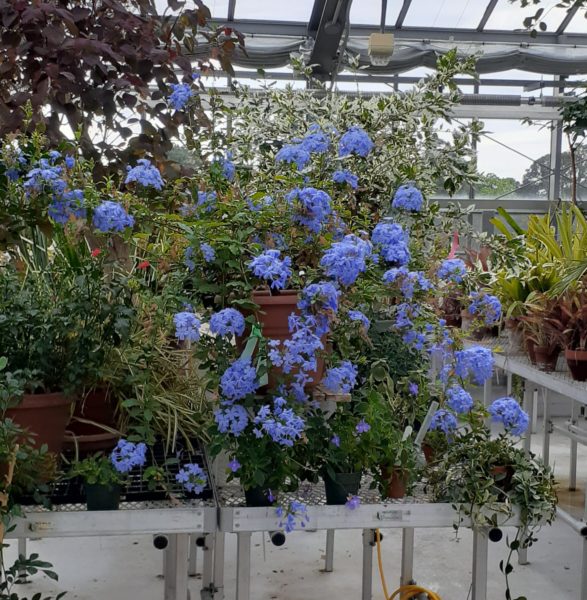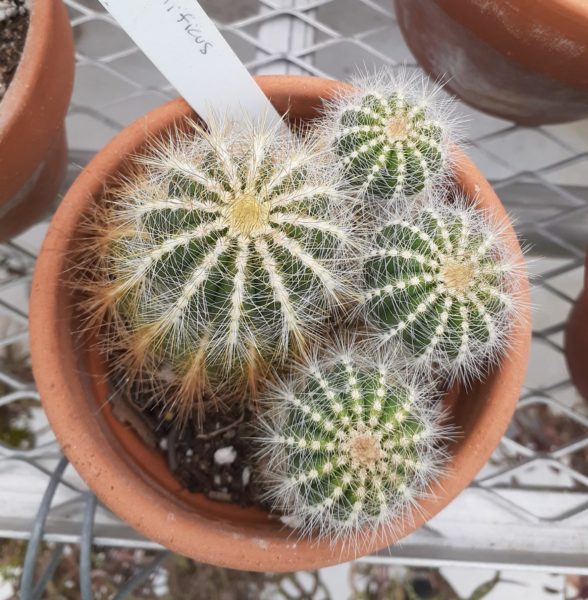Being Green in the Greenhouse
By Grace Dho ’23
Every now and then, it is nice to trade out the old brick buildings on campus for an exotic glass haven. The William & Mary Greenhouse sits on the top of the Integrated Science Center (ISC), looking over Barksdale Field. This lovely glass structure is full of different types of plants. We house native Milkweed for research, beautiful blooming Hibiscus, and feisty bug-eating Pitcher Plants. When you walk in the greenhouse, you are immediately greeted with a long shelf of plants lining the hallway. The greenhouse is then divided into 4 sections, each for a different type of plant. The first two sections, or bays, are used for research. The third bay houses part of the cactus collection, and it provides more space for research if needed. The fourth bay holds the greenhouse plant collection, which can range all the way from the rest of the cactus to blue Plumbagos. Though the greenhouse is mostly used for research and education purposes, many students also come to tour and spend time marveling at the fantastic collection of plants we house.
Recently, the greenhouse has received a Green Fee Grant through the William & Mary Office of Sustainability. The Green Fee Grant program was created by the President’s Committee on Sustainability in 2008. It provides funding to any student, staff, or faculty whose project goals align with the college sustainability goals. These goals not only aim to implement sustainable practices throughout the university but also to help inform the public about sustainability through community service. For our project, the greenhouse plans to install a compost bin system outside of the Integrated Science Center.
The compost bin system will consist of two compost bins: A sitting compost bin and a tumbling compost bin. The sitting compost bin will be filled with dead leaves and topped off with greener plant material. Since there is more coarse material in the sitting bin, the original carbon to nitrogen ratio can be altered. This means we can put in more green plant material. The tumbling compost bin keeps the compost material at a higher heat, and the rotating feature can allow more oxygen into the mixture. The tumbling compost method also completes the composting process quicker than the sitting compost. These bins will help the greenhouse reduce the amount of waste we produce by effectively recycling the discarded plant material into nutrient-rich soil. The composting system also serves to educate the public about composting. With the composting system outside the ISC, students and visitors can see where the composting magic happens. An informational sign will be placed outside the compost bins to inform any curious passerby about the processes currently unfolding inside. The greenhouse plans to distribute the compost to the public during Earth Week each year. People from William & Mary and the Greater Williamsburg community will have the opportunity to collect our compost to use for their own gardens or plants. By doing so, we hope to encourage other people to compost their compostable material and even encourage others to start their own composting system.
The greenhouse always tries to be sustainable, but despite literally being full of green, there are still many areas that need improvement. One of the main issues in the building is the infrastructure. The lights take up a lot of electricity since they are not LED, and the fans must always be running to provide air circulation. We also try to implement proper, eco-friendly biocontrol methods to help deal with pests. However, these methods of pest control are expensive, and the greenhouse lacks the funding for consistent usage of these methods. For now, we use pesticides that are meant for organic crops to keep our practices as sustainable as possible. As mentioned earlier, these are all areas in which the greenhouse hopes to improve upon, and we hope to implement these improvements sometime in the future.
Currently, due to COVID-19, the greenhouse is not accepting any visitors. Only one person is allowed in the building at a time, so the greenhouse manager, researchers, and volunteers must coordinate when they come in. However, we look forward to hosting more public events when we can. The entire greenhouse staff (and all the greenhouse plants) wish the new students a warm welcome during these unprecedented times, and we hope everyone has a safe semester!





No comments.
Comments are currently closed. Comments are closed on all posts older than one year, and for those in our archive.